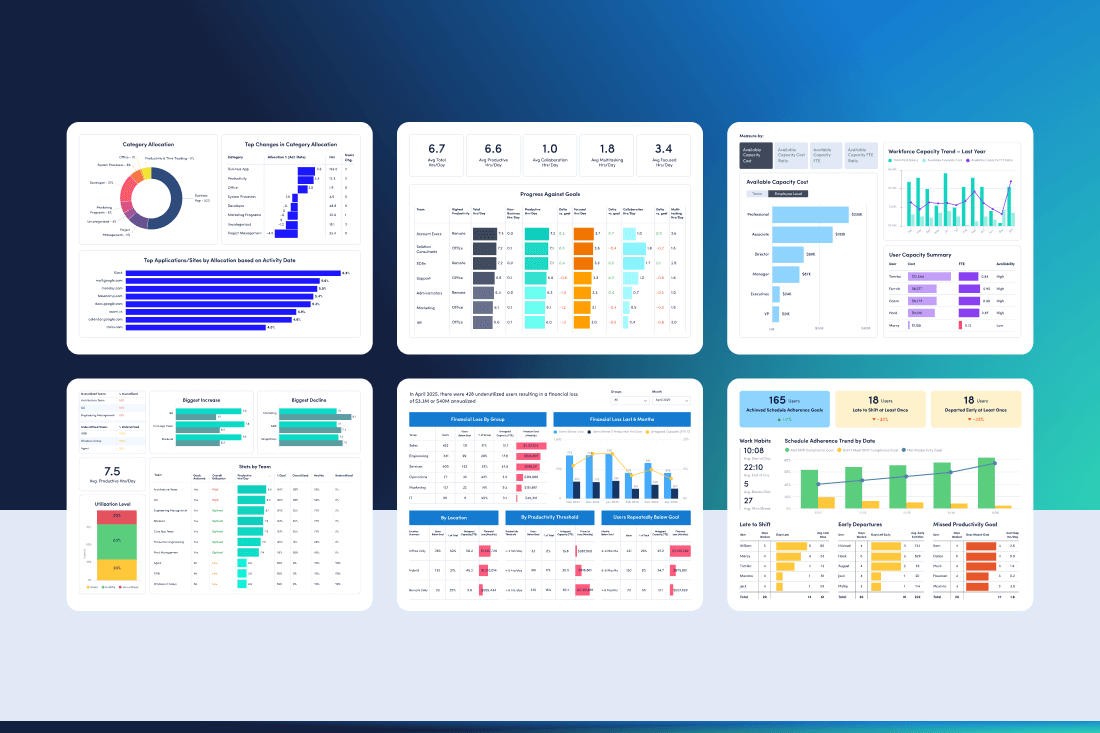Ever feel like you’re managing in the dark when your team works remotely? You’re not alone. That nagging worry about whether people are actually productive, the challenge of keeping everyone connected when they’re scattered across different time zones, the frustration of trying to read the room through a tiny video call window — it’s enough to make any manager question their approach.
Whether you’re feeling overwhelmed or want to take your remote leadership to the next level, these tips will help you build the kind of team culture where people do their best work — regardless of where they’re sitting.
1. Embrace individualized routines
One of the biggest advantages of remote work arrangements? Flexibility. Research has long shown remote workers are more likely to be engaged than onsite and hybrid employees. However, each employee has their own standards for where, when and how they work best. Some thrive by starting work early in the morning, while others work best late at night. For this reason, it’s important to allow individualized routines. Let employees choose the hours that work best for them, and ask them to share weekly work times so teammates know when to expect responses.
2. Establish core overlap hours
While flexibility is key to successful remote work, some overlap is necessary. Make your remote team more productive by setting shared “core hours” when you expect everyone to be available for collaboration and live check‑ins. Allow flexibility outside those times, but build them into your weekly schedule so teammates know when to connect.
3. Clarify roles, goals and expectations
Ensure each person understands what’s expected of them, from deliverables to success metrics to deadlines — and make it explicit. Schedule regular one‑on‑one meetings to discuss goals and address barriers to achieving them. In addition, take time to properly align each person to the right role. This goes a long way in ensuring every team member understands their responsibilities and meets their goals.
4. Set a schedule for weekly updates
In remote setups, silence breeds uncertainty. Ensure everyone stays connected by encouraging weekly updates — even when nothing major has changed — to maintain trust and keep asynchronous work moving. This helps build trust among team members without overwhelming people with constant pings and questions.
5. Optimize your technology
The right productivity tools are vital for remote workspaces — they boost collaboration, streamline processes and enhance performance. Evaluate your existing technology stack to identify which apps your employees rely on daily and which ones they rarely use. Then adjust accordingly. Optimizing your tech stack based on actual usage patterns empowers people to stay productive no matter where they work.
6. Balance autonomy and accountability
On one hand, managers need to know if remote employees perform as expected when working from home offices. On the other, constant oversight is bound to cause overwhelm and breed mistrust. Find the sweet spot by setting outcome‑based goals instead of tracking hours or active statuses. This empowers team members while ensuring progress, without resorting to micromanaging.
7. Foster informal social connection
Remote team members may not meet up at the local coffee shop, but that doesn’t mean you can’t foster social connections. Build in time for fun team building activities — virtual coffee breaks, online workshops and the like — to boost collaboration and reinforce a sense of belonging. These low‑stakes moments replicate hallway conversations that foster trust and cohesion.
8. Structure meetings for impact
Nothing kills remote productivity faster than Zoom fatigue. Evaluate schedules to eliminate unnecessary meetings and designate meeting-free time blocks to preserve focus time. Yes, virtual collaboration is essential for keeping remote team members on track. But rarely do projects warrant hours and hours of video calls. Keep sessions focused, short and purposeful by sending agendas in advance and sticking to time limits.
9. Promote well-being and boundaries
Remote employees are more likely than their in-office peers to experience anxiety and depression, making well-being initiatives a must. They often put in longer hours when working from home, where it’s harder to set boundaries between personal and professional lives. Model healthy work-life balance by reminding team members to step away, take regular breaks and log off after hours — this rest ensures people come to work fresh and energized.
10. Monitor for burnout
The risk of burnout is high when employees don’t clock in and out of the office, so it’s up to you to monitor for the early signs. Watch for overly long work hours, unbalanced workloads and missed deadlines — particularly among previous high performers. These all indicate it’s time to step in and make adjustments.
11. Use data to measure performance
Wondering how your team is performing? Rely on clearly defined KPIs or completed milestones — not screen status or hours worked. Whether you collect 360 degree feedback or use productivity measurement software, it’s important to track productivity of employees and teams. This helps you spot any potential issues with your remote workforce before they spiral into bigger problems.
12. Support career growth and recognition
The simple act of thanking team members goes a long way with remote workers. They don’t receive casual praise the same way in-person employees do, so it’s a good idea to go out of your way to recognize achievements. Look for ways to amplify wins, either verbally during meetings or in writing via email — especially for quiet collaborators. Getting into this habit works wonders for boosting camaraderie and commitment to work.
13. Iterate based on feedback
As your remote team grows and changes, so will communication and collaboration styles. Host regular ways of working discussions to understand what’s working, where to adjust and which preferences work best for everyone. This ensures everyone’s on the same page and helps prevent future issues.
Take the guesswork out of managing remote teams with ActivTrak
Effectively managing remote teams comes down to having the right insights at the right time. While the tips above are a great framework, many managers still struggle to understand how people actually work when they can’t see them in action.
This is where workforce analytics comes in. Instead of wondering whether remote employees are staying productive or burning out, you get clear visibility into work patterns, identify bottlenecks before they become problems and make data-driven decisions to support well-being.
With ActivTrak’s remote workforce management software, it’s easy to move beyond gut feelings and assumptions. You’ll see how remote workers spend their time, which tools help drive productivity and where adjustments are needed — all while respecting employee privacy and fostering trust. Schedule a demo for a behind the scenes look or create your free account to get started today.





